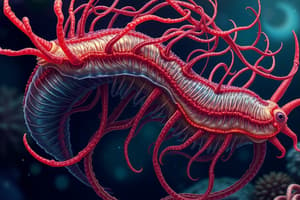Podcast
Questions and Answers
What is segmentation in annelids?
What is segmentation in annelids?
- The protective covering
- The process of movement
- The division of the body into repeating parts or segments (correct)
- The reproduction method
What are setae and what are they made of?
What are setae and what are they made of?
Setae are bristles or hair-like structures found on the body of annelids. They are made of chitin.
The clitellum is involved in movement and sensory functions.
The clitellum is involved in movement and sensory functions.
False (B)
Chaetae are found in the parapodia of __________ annelids.
Chaetae are found in the parapodia of __________ annelids.
Match the following annelid characteristics with their descriptions:
Match the following annelid characteristics with their descriptions:
Flashcards are hidden until you start studying
Study Notes
Annelida Characteristics
Segmentation
- Annelids are segmented worms, meaning their body is divided into repeating parts or segments.
- Each segment is similar in structure and function, but may have specialized features.
- Segmentation allows for greater flexibility and mobility.
Setae
- Setae (singular: seta) are bristles or hair-like structures found on the body of annelids.
- Setae are made of chitin, a tough, flexible polysaccharide.
- They provide protection, aid in movement, and help with burrowing.
Clitellum
- The clitellum is a specialized region on the annelid body used for reproduction.
- Found near the anterior (front) end of the body, it secretes a mucus ring that helps hold the worms together during mating.
- The clitellum also produces cocoons for egg-laying.
Chaetae
- Chaetae (singular: chaeta) are a type of seta that are found in the parapodia (appendages) of polychaete annelids.
- Chaetae are longer and more slender than setae, and are used for movement and sensory purposes.
- They are often found in rows or bundles on the parapodia.
Coelom
- The coelom is a fluid-filled body cavity that runs along the length of the annelid body.
- It is lined with mesodermal tissue and provides a space for internal organs to develop.
- The coelom also helps to maintain body shape and provides a hydrostatic skeleton, allowing for movement and flexibility.
Annelida Characteristics
Segmentation
- Annelids have a segmented body, which means their body is divided into repeating parts or segments.
- Each segment has a similar structure and function, but may have specialized features, allowing for greater flexibility and mobility.
Body Structures
- Annelids have setae (bristles or hair-like structures) on their body, which are made of chitin, a tough, flexible polysaccharide.
- Setae provide protection, aid in movement, and help with burrowing.
Reproduction
- The clitellum is a specialized region on the annelid body used for reproduction, located near the anterior (front) end of the body.
- The clitellum secretes a mucus ring that helps hold the worms together during mating.
- It also produces cocoons for egg-laying.
Polychaete Features
- Polychaete annelids have chaetae (a type of seta) in their parapodia (appendages).
- Chaetae are longer and more slender than setae, and are used for movement and sensory purposes.
- They are often found in rows or bundles on the parapodia.
Body Cavity
- The coelom is a fluid-filled body cavity that runs along the length of the annelid body.
- It is lined with mesodermal tissue and provides a space for internal organs to develop.
- The coelom helps to maintain body shape and provides a hydrostatic skeleton, allowing for movement and flexibility.
Studying That Suits You
Use AI to generate personalized quizzes and flashcards to suit your learning preferences.




